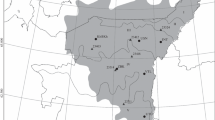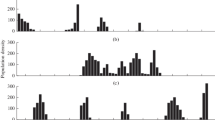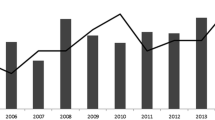Abstract
Flowering and fruiting as phenological events of 12 tree species in an evergreen tropical mountain rain forest in southern Ecuador were examined over a period of 3–4 years. Leaf shedding of two species was observed for 12 months. Parallel to the phenological recordings, meteorological parameters were monitored in detail and related to the flowering and fruiting activity of the trees. In spite of the perhumid climate of that area, a high degree of intra- and inter-specific synchronisation of phenological traits was apparent. With the exception of one species that flowered more or less continuously, two groups of trees could be observed, one of which flowered during the less humid months (September to October) while the second group started to initiate flowers towards the end of that phase and flowered during the heavy rains (April to July). As reflected by correlation coefficients, the all-time series of meteorological parameters showed a distinct seasonality of 8–12 months, apparently following the quasi-periodic oscillation of precipitation and related cloudiness. As revealed by power spectrum analysis and Markov persistence, rainfall and minimum temperature appear to be the only parameters with a periodicity free of long-term variations. The phenological events of most of the plant species showed a similar periodicity of 8–12 months, which followed the annual oscillation of relatively less and more humid periods and thus was in phase or in counter-phase with the oscillations of the meteorological parameters. Periods of unusual cold or dryness, presumably resulting from underlying longer-term trends or oscillations (such as ENSO), affected the homogeneity of quasi-12-month flowering events, fruit maturation and also the production of germinable seeds. Some species show underlying quasi-2-year-oscillations, for example that synchronise with the development of air temperature; others reveal an underlying decrease or increase in flowering activity over the observation period, influenced for instance by solar irradiance. As Ecuador suffers the highest rate of deforestation in South America, there is an urgent need for indigenous plant material for reforestation. A detailed knowledge of the biology of reproduction in relation to governing external factors (mainly climate) is thus required.















Similar content being viewed by others
References
Andĕl J (1984) Statistische Analyse von Zeitreihen. Akademie-Verlag, Berlin
Balslev H, Øllgaard B (2002) Mapa de vegetación del sur de Ecuador. In: Aguirre Z, Madsen JE, Cotton E, Balslev H (eds) Botánica austroecuatoriana. Estudios sobre los recursos vegetales en las provincias de El Oro, Loja y Zamora-Chinchipe. Ediciones Abya-Yala, Quito Ecuador, pp 51–64
Beck E, Müller-Hohenstein K (2001) Analysis of undisturbed and disturbed tropical mountain forest ecosystems in Southern Ecuador. Die Erde 132:1–8
Bendix J (2000) A comparative analysis of the major El Niño events in Ecuador and Peru over the last two decades. Zbl Geol Paläontol Teil I 1999, H. 7/8:1119–1131
Bendix J (2004) Climate variability and extreme events in the Andes of Ecuador and Peru (in German). Geogr Rdsch 56:10–16
Bendix J, Lauer W (1992) Die Niederschlagsjahreszeiten in Ecuador und ihre klimadynamische Interpretation. Erdkunde 46:118–134
Bendix J, Bendix A, Richter M (2000) El Niño 1997/98 in Nordperu: Anzeichen eines Ökosystem-Wandels? Petermanns Geogr Mitt 2000/4:20–31
Bendix J, Fabian P, Rollenbeck R (2004a) Gradients of fog and rain in a tropical montane cloud forest of southern Ecuador and its chemical composition. In: Proceedings of the 3rd International Conference on Fog, Fog Collection and Dew, 11–15 October 2004, Cape Town, South Africa, pp H7-1–H7-4
Bendix J, Rollenbeck R, Palacios WE (2004b) Cloud detection in the Tropics—a suitable tool for climate-ecological studies in the high mountains of Ecuador. Int J Remote Sensing 25:4521–4540
Bendix J, Rollenbeck R, Reudenbach C (2006) Diurnal patterns of rainfall in a tropical Andean valley of southern Ecuador as seen by a vertically pointing K-band Doppler radar. Int J Climatol 26 DOI:10.1002/joc.1267
Blackman RB, Tukey JW (1958) The measurement of power spectra. Dover, New York
Blázquez M, Ahn JH, Weigel D (2003) A thermosensory pathway controlling flowering time in Arabidopsis. Nat Genet 33:168–171
Borchert R (1983) Phenology and control of flowering in tropical trees. Biotropica 15:81–89
Borchert R, Renner SS, Calle Z, Navarrete D, Tye A, Gautier L, Spichiger R, von Hildebrand P (2005) Photoperiodic induction of synchronous flowering near the Equator. Nature 3295:1–3
Boss PK, Bastow RM, Mylne JS, Dean C (2004) Multiple pathways in the decision to flower: enabling, promoting, and resetting. Plant Cell 16:S18–S31
Briggs W, Ruppert D (2005) Assessing the skill of yes/no forecasts for Markov observations. http://www.orie.cornell.edu/~davidr/papers/weathermarkov03.pdf
Bussmann RW (2001) The montane forest of Reserva Biológica San Francisco (Zamora-Chinchipe, Ecuador). Die Erde 132:9–25
Caldwell MM (1968) Solar ultraviolet radiation as an ecological factor for Alpine plants. Ecol Monogr 38:243–268
Caldwell MM, Björn LO, Bornman JF, Flint SD, Kulandaivelu G, Teramura AH, Tevini M (1998) Effects of increased solar ultraviolet radiation on terrestrial ecosystem. J Photochem Photobiol B46:40–52
Croat T (1975) Phenological behavior of habitat and habitat classes on Barro Colorado Island (Panama Canal Zone). Biotropica 7:270–277
Daubenmire R (1972) Phenology and other characteristics of tropical semideciduous forest in north-western Costa Rica. J Ecol 60:147–170
Dziedzioch C, Stevens A-D, Gottsberger G (2003) The hummingbird plant community of a tropical montane rain forest in Southern Ecuador. Plant Biol 5:331–337
Endler JA (1993) The color of light in forests and its implications. Ecol Monogr 63:1–27
Flint SD, Caldwell MM (1984) Partial inhibition of in vitro pollen germination by simulated solar ultraviolet-B radiation. Ecology 65:792–795
Frankie GW, Baker HG, Opler PA (1974) Comparative phenological studies of trees in tropical wet and dry forests in the lowlands of Costa Rica. J Ecol 62:881–913
Graham EA, Mulkey SS, Kitajima K, Phillips NG, Wright SJ (2003) Cloud cover limits net CO2 uptake and growth of a rainforest tree during tropical rainy seasons. Proc Natl Acad Sci USA 100:572–576
Hamann A (2004) Flowering and fruiting phenology of a Philippine submontane rain forest: climatic factors as proximate and ultimate causes. J Ecol 92:24–31
Hamann A, Curio E (1999) Interactions among frugivores and fleshy fruit trees in a Philippine submontane rain forest. Conserv Biol 13:766–773
Harling G, Andersson L (eds) (1973–2003) Flora of Ecuador, vol 1–68. University of Göteborg, Göteborg
Homeier J (2004) Baumdiversität, Waldstruktur und Wachstumsdynamik zweier tropischer Bergregenwälder in Ecuador und Costa Rica. PhD Thesis, University of Bielefeld
Homeier J, Dalitz H, Breckle S-W (2002) Waldstruktur und Baumartendiversität im montanen Regenwald der Estación Científica San Francisco in Südecuador. Ber Reinh-Tüxen Ges 14:109–118
Ims RA (1990) The ecology and evolution of reproductive synchrony. Trends Ecol Evol 5:135–140
Klaus D (1977) Klimafluktuationen in Mexiko seit Beginn der meteorologischen Beobachtungsperiode. Abh Akad Wiss Lit Mainz Jhrg 1977 Nr 1. Franz Steiner Verlag, Wiesbaden
Koptur S, Haber WA, Frankie GW, Baker HG (1988) Phenological studies of shrubs and treelet species in tropical cloud forests of Costa Rica. J Trop Ecol 4:323–346
Lobo JA, Quesada M, Stoner KE, Fuchs EJ, Herrerías-Diego Y, Rojas J, Saborio G (2003) Factors affecting phenological patterns of bombacaceous trees in seasonal forests in Costa Rica and Mexico. Am J Bot 90:1054–1063
McPhaden MJ (2004) Evolution of the 2002/03 El Niño. Bul Am Meteor Soc 85:677–695
Mikich SB, Silva SM (2001) Floristic and phenological study of zoochoric species of semideciduous seasonal forest remnants in the mid-west region of Parana State, Brazil. Acta Bot Bras 15:89–113
Miller C (1998) Rates of rainforest destruction and species loss. http://www.ecuadorexplorer.com/html/body_rf_destuction.html
Müller-Hohenstein K, Paulsch A, Paulsch D, Schneider R (2004) Vegetations- und Agrarlandschaftsstrukturen in den Bergwäldern Südecuadors. Geogr Rdsch 56:48–55
Nann S, Riordan C (1991) Solar spectral irradiance under clear and cloudy skies: measurements and a semiempirical model. J Appl Meteorol 30:447–462
Newstrom LE, Frankie GW, Baker HG (1994) A new classification for plant phenology based on flowering patterns in lowland tropical forest trees at La Selva, Costa Rica. Biotropica 26:141–159
Numata S, Yasuda M, Okuda T, Kachi N, Noor NSM (2003) Temporal and spatial patterns of mass flowerings on the Malay peninsula. Am J Bot 90:1025–1031
Nunez M, Forgan B, Roy C (1994) Estimating ultraviolet radiation at the Earth’s surface. Int J Biometeorol 38:5–17
Olberg M, Rákóczi F (1984) Informationstheorie in Meteorologie und Geophysik. Akademie-Verlag, Berlin
Opler PA, Frankie GW, Baker HG (1980) Comparative phenological studies of treelet and shrub species in tropical wet and dry forests in the lowlands of Costa Rica. J Ecol 68:167–188
Poulin BS, Wright SJ, Lefebvre G, Calderon O (1999) Interspecific synchrony and asynchrony in the fruiting phenologies of congeneric bird-dispersed plants in Panama. J Tropical Ecol 15:213–227
Rathcke B, Lacey EP (1985) Phenological patterns of terrestrial plants. Annu Rev Ecol Syst 16:179–214
Reich PB, Borchert R (1982) Phenology and ecophysiology of the tropical tree, Tabebuia neochrysantha (Bignoniaceae). Ecology 63:294–299
Richter M (2003) Using epiphytes and soil temperatures for eco-climatic interpretations in Southern Ecuador. Erdkunde 57:161–181
Rollenbeck R, Bendix J (2006) Experimental calibration of a cost-effective X-band radar for climate-ecological use in southern Ecuador. Atmos Res 79:296–316
Rollenbeck R, Fabian P, Bendix J (2006) Precipitation dynamics and chemical properties in tropical mountain forests of Ecuador. Adv Geosci 6:73–76
Sakai S (2002) General flowering in lowland mixed dipterocarp forest of South Asia. Biol J Linn Soc 75:233–247
Sakai S, Momose K, Yumoto T, Nagamitsu T, Nagamasu H, Hamid AA, Nakashizuka T (1999) Plant reproductive phenology over four years including an episode of general flowering in a lowland Dipterocarp forest, Sarawak, Malaysia. Am J Bot 86:1414–1436
Schöngart J, Piedade MTF, Ludwigshausen F, Horna V, Worbes M (2002) Phenology and stem-growth periodicity of tree species in Amazonian floodplain forests. J Trop Ecol 18:581–597
Shukla RP, Ramakrishnan PS (1982) Phenology of trees in a sub-tropical humid forest in north-eastern India. Vegetatio 49:103–109
Simpson GG, Dean C (2002) Arabidopsis, the Rosetta stone of flowering time? Science 296:285–289
Singh KP, Kushwaha CP (2005) Emerging paradigms of tree phenology in dry tropics. Curr Sci 89:964–975
Stiles FG (1977) Coadapted competitors: the flowering seasons of hummingbird-pollinated plants in a tropical forest. Science 198:1170–1178
Tevini MM, Teramura AH (1989) UV-B effects on terrestrial plants. Photochem Photobiol 50:479–487
Valencia R, Cerón C, Palacios W, Sierra R (1999) Las formaciones naturales de la sierra del Ecuador. In: Sierra R (ed) Propuesta preliminar de un sistema de clasificación de vegetación para el Ecuador continental. Proyecto INEFAN/GEF-BIRF y EcoCiencia, Quito, pp 79–108
Vuille M, Bradley RS, Keimig F (2000) Climate variability in the Andes of Ecuador and its relation to tropical Pacific and Atlantic sea surface temperature anomalies. J Clim 13:2520–2535
Wolff D, Braun M, Liede S (2003) Nocturnal versus diurnal pollination success in Isertia laevis (Rubiaceae): a sphingophilous plant visited by hummingbirds. Plant Biol 5:71–78
Wright SJ, Cornejo FH (1990) Seasonal drought and leaf fall in a tropical forest. Ecology 71:1165–1175
Wright SJ, van Schaik CP (1994) Light and the phenology of tropical trees. Am Nat 143:192–199
Wright SG, Carrasco C, Calderón O, Paton S (1999) The El Niño southern oscillation, variable fruit production, and famine in a tropical forest. Ecology 80:1632–1647
Zipparro VB (2004) Climate as a proximate factor affecting phenology of Atlantic rain forest trees. http://ams.confex.com/ams(AFAPUBBIO/techprogram/paper 78878.htm
Acknowledgements
This work was performed as part of the research programme FOR 402 “Functionality in a Tropical Mountain Rainforest: Diversity, Dynamic Processes and Utilisation Potentials under Ecosystem Perspectives”, funded by the Deutsche Forschungsgemeinschaft (DFG) and also supported by the foundation Nature and Culture International (San Diego and Loja). The authors gratefully acknowledge the skillful assistance of Dr. Rütger Rollenbeck with the meteorological recordings and the correction of the raw data sets.
Author information
Authors and Affiliations
Corresponding author
Rights and permissions
About this article
Cite this article
Bendix, J., Homeier, J., Cueva Ortiz, E. et al. Seasonality of weather and tree phenology in a tropical evergreen mountain rain forest. Int J Biometeorol 50, 370–384 (2006). https://doi.org/10.1007/s00484-006-0029-8
Received:
Revised:
Accepted:
Published:
Issue Date:
DOI: https://doi.org/10.1007/s00484-006-0029-8




